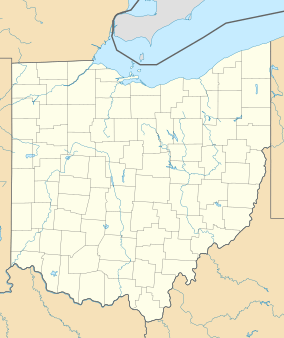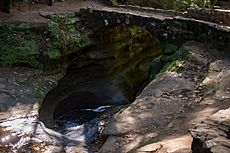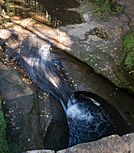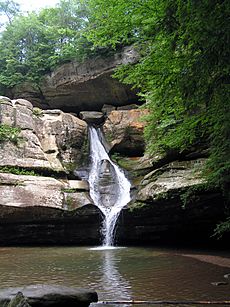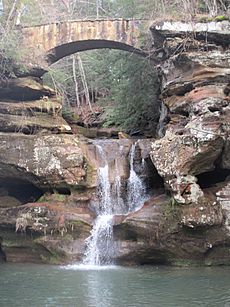Hocking Hills State Park facts for kids
Quick facts for kids Hocking Hills State Park |
|
|---|---|
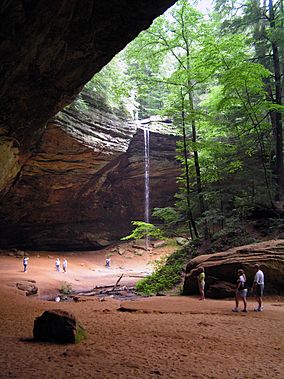
Ash Cave
|
|
| Location | Hocking County, Ohio, US |
| Nearest city | Logan, Ohio |
| Area | 2,356 acres (9.53 km2) Water: 17 acres (6.9 ha) |
| Established | 1924 |
| Governing body | Ohio Department of Natural Resources |
Hocking Hills State Park is an awesome state park located in Hocking County, Ohio, USA. It's a super popular spot for outdoor adventures. You'll find over 25 miles (40 km) of exciting hiking trails here.
The park is famous for its cool rock formations, beautiful waterfalls, and unique recess caves. The trails are open all year, from sunrise to sunset, so you can visit anytime!
Hocking Hills State Park has seven main hiking areas to explore:
- Ash Cave
- Cantwell Cliffs
- Cedar Falls
- Conkle's Hollow (a special nature preserve)
- Old Man's Cave
- Rock House
- Hemlock Bridge Trail to Whispering Cave
Contents
Discovering Hocking Hills: A Look at Its Past
How Hocking Hills Got Its Name
The name "Hocking" comes from the Hockhocking River. In the Lenape language, "Hockhocking" means "bottle." The Shawnee Tribe also called it "Wea-tha-Kagh-Qua-sepe," which means "bottle river."
This name came from a waterfall on the river. It was about 20 feet tall and located near Lancaster. Above the falls, the river was very narrow and straight, like the neck of a bottle!
A Timeline of Hocking Hills History
- 1700s: Native American tribes like the Delaware, Wyandot, and Shawnee lived in and traveled through this area.
- 1818: Hocking County was officially created in Ohio.
- 1924: Hocking Hills became a state park! This happened after people realized how popular the hiking spots were. A law passed in 1915 allowed the state to buy the first piece of land around Old Man's Cave.
How the Park's Amazing Landscape Was Formed
Millions of years ago, about 330 million years ago, the Hocking Hills area was flat. It was covered by the Atlantic Ocean! Over a very long time, the ocean currents dropped huge amounts of sand and gravel.
When the ocean left, the sand turned into a special rock called Black Hand Sandstone. This sandstone formed like a sandwich, with hard layers on top and bottom and a softer layer in the middle. Later, when the Appalachian Mountains formed, they shaped the land, creating the Hocking Hills you see today.
The Impact of Ancient Glaciers
About 10,000 years ago, a giant ice sheet called the Wisconsin Glacier began to melt. This caused huge floods in the Hocking Hills area. The glacier stopped just north of Hocking County.
The melting ice created powerful water torrents. These torrents found cracks in the hard top layer of sandstone. The water then washed away the soft middle layer. This created long tunnels, which are now the gorges we explore!
Eventually, the heavy top layers of rock fell down. These fallen rocks are called "slump rocks" and you can still see them in the gorges. Over just a few centuries, the rushing glacial waters carved the soft sandstone into the cool shapes and wrinkles you see on the cliffs and in the grottos.
Early settlers found a black human handprint on a cliff in Muskingum County. This cliff was made of the same Black Hand Sandstone. You can see this same type of sandstone in six different areas of Hocking Hills State Park.
Planning Your Visit: Tourist Information
Hocking Hills is a very popular place for visitors! Over 2 million people came to the park in 2017. To help with parking, a special shuttle service started in 2017 from downtown Logan.
The Ohio Department of Natural Resources (ODNR) also built a brand new visitors' center. This $6 million project opened in June 2019, making your visit even better!
Where to Stay and What to Expect
The park has about 200 campsites, and most of them have electricity. The campground is super close to all the hiking trails. It also has modern restrooms with hot showers, vending machines, a camp store, and even a swimming pool!
If camping isn't your thing, there are also many cabins and hotels nearby.
Fun Activities and Attractions at Hocking Hills
The Hocking Hills area is packed with fun things to do! Besides the state park, you'll find many private inns, campgrounds, cabins, and restaurants. There's even a zipline!
Nature and Outdoor Adventures
- Nearby Natural Areas: Besides Hocking Hills State Park, you can visit other cool spots like Hocking State Forest, Conkles Hollow State Nature Preserve, Lake Logan State Park, and Rockbridge State Nature Preserve. These places also have deep gorges and high cliffs made from the same Blackhand Sandstone.
- Lakes for Fun: Lake Logan in Hocking Hills State Park is a big lake, covering 400 acres. It was built in 1955 for recreation. You can go hiking, boating, picnicking, and swimming there.
- Water Sports: Canoeing, kayaking, and rafting are popular activities on the rivers and lakes in Hocking Hills.
- Rock Climbing and Rappelling: If you're looking for an adventure, 99 acres of forest land in Hocking State Forest are set aside for rock climbing and rappelling.
- Swimming Spots: Lake Logan and Rose Lake offer great places to swim and relax on beaches. There's also a swimming pool open to the public near the Hocking Hills State Park lodge.
- Hunting and Fishing: If you have the right permits, you can go hunting during hunting season. Fishing is allowed in Lake Logan, where you might catch bluegill, crappie, bass, saugeye, and catfish.
- Bird Watching: The Hocking Valley Birding Trail helps bird watchers find the best spots to see different kinds of birds in Hocking Hills.
- Archery Range: Hocking Hills State Park has a free archery range where you can practice your shooting skills.
- Horseback Riding: You can explore the park on horseback! Hocking Hills State Park has special trails for horseback riding.
- Astronomy Park: The John Glenn Astronomy Park opened in 2018. It's named after astronaut and US Senator John Glenn. During the day, you can learn about the sun. At night, you can see planets and stars clearly because there's not much light pollution.
Unique Experiences
- Air Tours: Hocking Hills Scenic Air Tours offers airplane rides. You can get an amazing view of the State Park from above!
- Train Rides: The Hocking Valley Scenic Railway offers train rides. It's a fun way to learn about the history of transportation and industry in the Hocking Hills area.
- Canopy Tours: Hocking Hills Canopy Tours is nearby and offers exciting zipline adventures. They have different rides, including a SuperZip and a Nightflight. The Hocking Hills region is even called the "Canopy Tour Capital of the Midwest"!
Plants of Hocking Hills
Hocking Hills is home to some rare and interesting plants. You might find plants here that don't usually grow in this region. Examples include Canada yew and Bigleaf magnolia.
Popular Hiking Trails
There are many hiking trails in the state park, and some are even safe for your pets! Here are some of the popular trails and their lengths:
- Old Man's Cave: 1 mile
- Ash Cave Gorge: 1⁄4 mile (wheelchair accessible!)
- Ash Cave Rim: 1⁄2 mile
- Cedar Falls: 1⁄2 mile
- Rock House: 1 mile
- Cantwell Cliffs: 1 mile
- Conkle's Hollow: 1 mile
- Conkle's Hollow Rim: 21⁄2 miles
- Buckeye Trail:
- Cedar Falls – Ash Cave: 3 miles
- Old Man's Cave – Cedar Falls: 3 miles
Other Cool Places to Explore Nearby
Hocking Hills State Park is surrounded by other protected lands. It's actually inside the Hocking State Forest! There are also private preserves like Crane Hollow Nature Preserve.
Camp Oti-Okwa, owned by Big Brothers-Big Sisters, is another large protected area nearby. While there are three state nature preserves within the forest, only Conkles Hollow State Nature Preserve is open to the public.
Other nearby parks include Clear Creek Metro Park, Lake Logan State Park, and Rockbridge State Nature Preserve.
Images for kids


